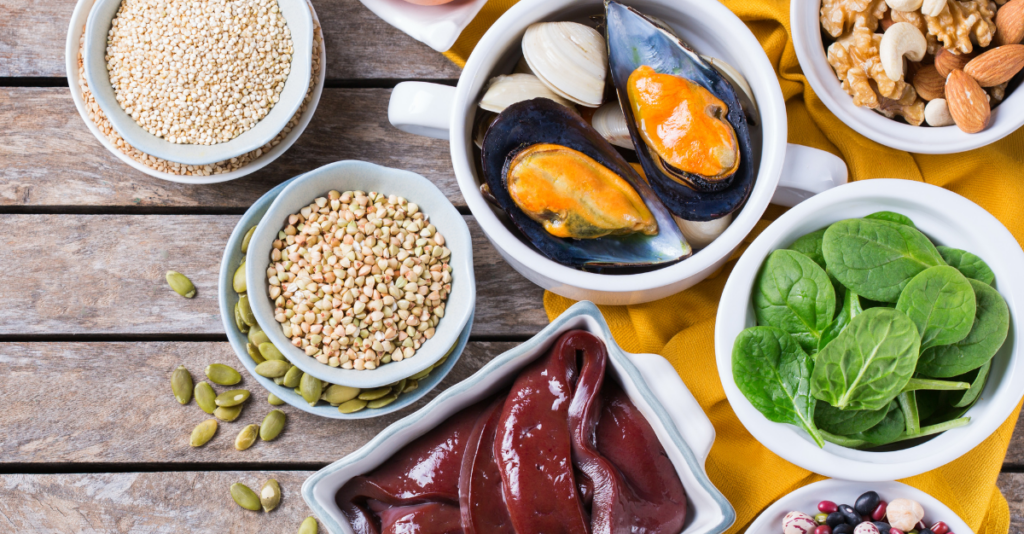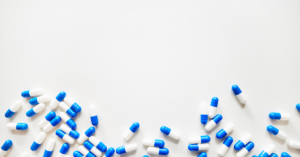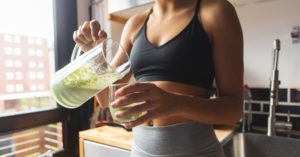Iron is an essential mineral that helps maintain many vital functions in the body. This includes the production of hemoglobin, a protein in red blood cells that helps transport oxygen throughout the body. Consuming enough iron is important. Without it, your body will struggle to produce enough healthy red blood cells. Iron levels impact many aspects of your health, including:
- Energy
- Ability to focus
- Gastrointestinal health
- Your immune system
- Regulation of body temperature
- Skin, hair, and nails
Heme vs. Non-Heme Iron
Dietary iron comes in two forms – heme and non-heme. Heme iron is only found in animal proteins such as meat, poultry, and seafood. Heme iron is more easily absorbed into the body and is thus a significant source of dietary iron for many.
By contrast, non-heme iron is present in plant-based foods such as grains, beans, vegetables, nuts, and seeds. It is also present in dairy and eggs. The body processes non-heme iron differently and has to alter non-heme iron to absorb it fully. This means that a lower percentage of non-heme iron is absorbed.
Iron Deficiency is Common: Know The Symptoms
Ideally, there is a healthy balance between the supply of iron through the diet and the body’s demand for iron. However, if demand outweighs supply, the body starts to use up iron stored in the liver, which can lead to iron deficiency. When the body has used the iron up, it cannot produce more hemoglobin. This condition is called iron deficiency anemia.
Iron deficiency is very common. Symptoms of iron deficiency include:
- Fatigue
- Shortness of breath
- Cold hands or feet
- Lightheadedness or dizziness, particularly when standing up quickly
- Pale or sallow skin, nails, or gums
- Headache
- Irregular heartbeat
- Unexplained irrational cravings – the desire to consume things like ice or paper is a sign of anemia
- A sore or swollen tongue
- Hair loss
- Restless legs
- Unexplained itchiness
Who is more likely to suffer from iron deficiency?
Certain demographics are more likely to deal with iron deficiency than others.
- Women of childbearing age are especially at risk, because their bodies use and require a great deal of iron during menstruation, pregnancy and breastfeeding. Women with fibroids or other conditions that cause heavy periods are at increased risk.
- Young people undergoing puberty are also disposed to iron deficiency since rapid growth necessitates a higher intake.
- Vegetarians or vegans also tend to be at a greater risk for iron deficiency, since their diets often exclusively contain non-heme iron which is absorbed less easily than the heme iron found in meats.
- Iron deficiency is also commonly present in people who have recently undergone major surgery or physical trauma, and in those with gastrointestinal disorders such as Crohn’s.
- Some studies have found that people dealing with a lot of stress are at higher risk of anemia.
- High-level athletes or people who exercise a lot also have a higher risk. Because iron deficiency impacts athletic performance, athletes must pay close attention to their iron levels.
- Regular blood donors should monitor their iron levels and work with their healthcare practitioner to work out a donation schedule that works for them.
- People who abuse alcohol can deplete their iron levels, in part because alcohol can inhibit the body’s ability to absorb iron.
Preventing Iron Deficiency
If you fit into one of these categories, or if you are generally concerned about your iron levels, do not fret. There are simple steps you can take to increase your iron absorption and ensure you are feeling your best.
Ultimately, it is important to consume foods that contain iron, as your body does not produce the nutrient on its own. Add these iron-rich foods into your diet to prevent/treat iron deficiency:
- Red meat is known to be the most easily accessible source of heme iron. It also contains B vitamins and quality protein.
- Fish also contains numerous health benefits, including being high in iron. The omega 3 fatty acids found in fish like salmon, tuna, and haddock are great for brain health. And just one serving of canned tuna can provide 8% of your daily value of iron.
- Turkey is another healthy source of iron. It also is a great source of protein. Dark turkey meat tends to contain more iron than white, with a 3.5 ounce portion containing 8% of the daily value.
- Shellfish, particularly clams, mussels, and oysters, are good sources of heme-iron.
For vegetarians:
- Spinach is a great source of non-heme iron for vegetarians; 100 grams of raw spinach provides 15% of your daily value.
- Legumes are another nutrient-packed option for vegetarians trying to increase their iron intake. Black beans, kidney beans, and lentils can all help raise iron levels.
- Pumpkin seeds are an easy snack and a great source of non-heme iron. A one-ounce serving contains 14% of your daily value of iron.
- Tofu is a popular staple in vegetarian diets and happens to provide 3.4 mg of iron in a half-cup serving. This amounts to 19% of your daily value.
Vitamin C helps your body to absorb iron. Including a source of Vitamin C, like broccoli, with your iron-rich meal will help maintain iron levels. Beta carotene, which is found in brightly colored produce like peppers, carrots, and apricots, can also boost absorption.
You should also examine your diet for foods and drinks that can lower iron levels, including coffee, tea, many sodas, alcohol and some dairy products.
Treating Iron Deficiency
Identifying the causes of iron deficiency is the first line of defense. From there, increasing the iron consumption in your daily diet is an important next step.
Depending on your iron levels and diet, supplements may also be necessary, but it’s important to work with a healthcare practitioner. Too much iron can be harmful to your health, so you need to find the right levels for you. keeping in mind that your body is unable to rid itself of excess iron. As well, many people find iron supplements can lead to an upset stomach and constipation, so you may have to make dietary changes at the same time.
Iron deficiency can cause serious complications for your health if left untreated, so it is important to get a proper assessment of your iron levels and create a treatment plan to help raise them. Let us know if you need help addressing iron deficiency – we’re here to help!
Sources:
Wei C, Zhou J, Huang X, Li M. Effects of psychological stress on serum iron and erythropoiesis. Int J Hematol. 2008 Jul;88(1):52-56. doi: 10.1007/s12185-008-0105-4. Epub 2008 Jun 11. PMID: 18543064.
Damian MT, Vulturar R, Login CC, Damian L, Chis A, Bojan A. Anemia in Sports: A Narrative Review. Life (Basel). 2021;11(9):987. Published 2021 Sep 20. doi:10.3390/life11090987
Shuchman M. Frequent blood donors risk iron deficiency. CMAJ. 2014;186(11):817. doi:10.1503/cmaj.109-4807
Abbaspour N, Hurrell R, Kelishadi R. Review on iron and its importance for human health. J Res Med Sci. 2014;19(2):164-174.
U.S. Department of Agriculture, Food data central
Carmen Lúcia de Almeida SantosI, II; Marco AkermanIII; Odival FaccendaIV; Lourdes Conceição MartinsV; Lígia de Fátima Nóbrega Reato,, Iron defici, 2012/01/01





